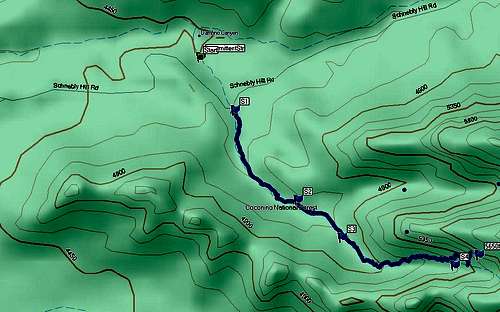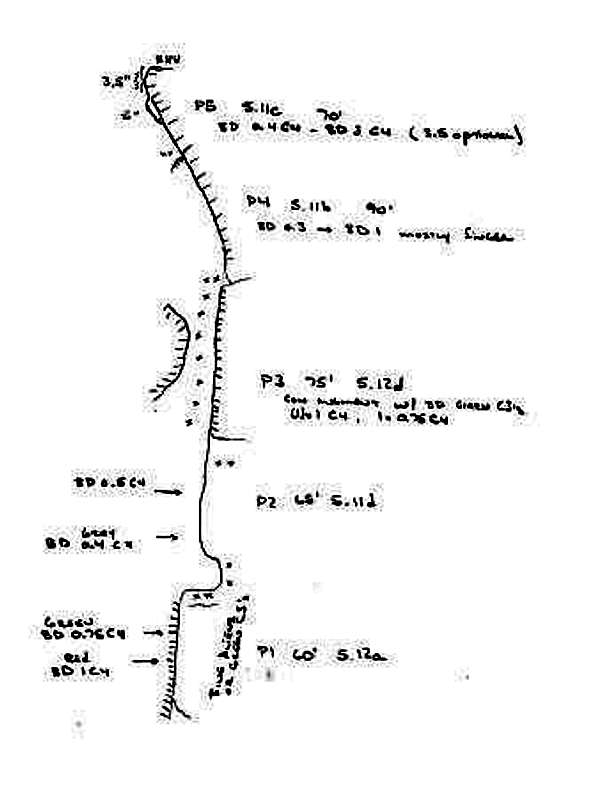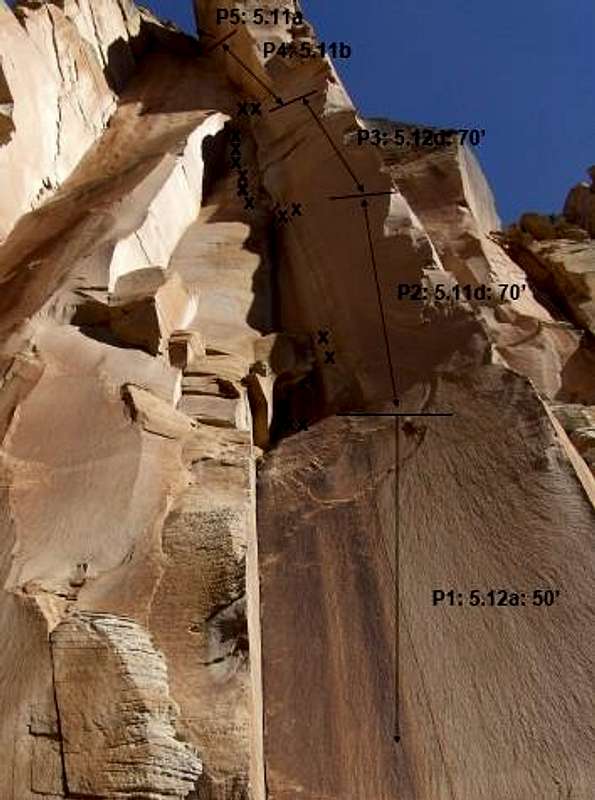|
|
Mountain/Rock |
|---|---|
|
|
34.85800°N / 111.733°W |
|
|
Trad Climbing |
|
|
Spring |
|
|
Overview
Shangri-la (IV mixed; 5.12d) (5.13a with first picth variation) Introduction: Shangri-la is by far the best long route in Sedona and probably in Arizona to date, assuming that you can do it. Ok the route 20ft to the right Lost Horizons 5.13) has been said to be even better but only a handful of people have done the route. Shangri-la has been compared to many of the best desert climbs in the Southwest and is worth doing. Strategy: There are two main ways of doing the route. 1) 5 pitches: The route is set up as a five pitch route (and will be described in the beta as this way). The bolted belay stations make sense as where they are. The first belay is a small comfortable sloping ledge. The second belay is a semi-hanging belay with a broken 6” ledge. The third belay is a small ledge where you can stand. The fourth belay is the most comfortable belay and then you have the top 2) 3 or 2 pitches: It is common to run pitches 1 and 2 together and pitches 4 and 5 together. With a 70 meter rope and the liberal use of long slings pitches 1, 2 and 3 can be run together as a mega-pitch and has been done by Mike Sokaloff in October 2009 but it may have been done this way earlier by someone else. The route has the potential to be done without the bolts but the first ascensionists should be respected and they should be left in place. History: The first ascent as an aid route was by D. Bloom, T. Consentino, C. Ellison, M. Clifton, D. Suess (1997). The first free ascent was by Rodman and David Bloom in October 1999. Additional History: In November of 2009 Kyle Edmonson and Matt did the first and second lead of the first pitch variation going at 5.13a. Also in November of 2009 Mike Sokoloff did the third pitch TOTALLY on gear bypassing the bolts. C. Claude had bypassed the bolts on Pitch 2 (which is no big deal) so the route has been done totally on gear now (if not previously but no previous ascent on gear had been made public) Note: With the picture of the 3rd pitch in Climbing December 2010, one may ask why the bolts on the third pitch when the small crack is so clearly visible. When Ellison and Bloom, et.al did the rout in 1999, the narrowest small gear was the CCH Alien which was about the same width as the Metolius 3-cam. The crack is so narrow as not to accept the cam lobes safely. Only with the advent of the BD C3's did the head of the cam become narrow enough that the cam could potentially hold a fall. After Sokoloff/Claude ascent on gear a discussion was held about the fatew of the bolts and as of 2009/2010 the consensus of the Northern Arizona climbing community with the input of the original first ascentionists is that the bolts should remain.
Getting There
Note: This is on National Forest land and in theory a parking pass is required. The parking pass can be bought at a kiosk about 400m up the road at a trailhead before Damfino Canyon is reached.
Start at Damfino Canyon ( N 34 51.998 W111 44.660) which is at a sharp turn at the bottom of a hill on Schniebly Canyon Road. Walk up the wash to the west for 10minutes. A cairn (at about N34 51.573 W111 44.113) will be found on the right side of the canyon at the entrance to Lost Canyon. Continue up Lost Canyon staying in the very bottom of the wash until you are just below the formation at the end of the canyon, where a wash can be seen going directly up to the formation on the left (at about N34 51.492 W111 43.629). Leaving the wash will be rewarded with heavy brush, prickly pear cacti and rattlesnakes. Allow 50-60minutes for the approach.
Beta
Pitch 1: 60ft (5.12a or 5.13a with variation) tips only crack ( 5 x blue CCH Aliens or Green BD C3’s; can be supplemented with a BD Red (1) C4 and a BD Green (0.75) C4. Climb the tips only crack until you bump to the arete just below the first hand pod. Climb the arete and corner until yopu reach a stance and 2 bolts at the belay. The variation is if you forgo the arete and stick only to the tips only crack, first led 11/2009 (5.13a). Protection is good.
Pitch 2: 65ft (5.11d) 2-3x BD grey (0.4) C4’s and 3-5x BD 0.5 C4’s. A BD Blue (0.3) C4 will protect the start if you so wish. Climb straight off the belay to the flake (heading straight up instead of directly to the flake is easier). Once you gain the ledge you can clip the second bolt with a long sling (first bolt is almost irrelavent and often isn’t clipped).It is also possible to place a blue 0.3 BD C4 at the same level as the bolt instead of clipping. Mantle onto the top of the flake and rest. Start up the tight fingers to fingers layback flake. Endurance 5.11d (not hard but strenuous) and easier if you place less gear, as the crack tapers from grey BD (0.4) C4’s to purple BD (0.5) camalots, reaching a ledge/belay at the bolts with chains.
Pitch 3: 75ft (5.12d; 8 bolts and can supplement with gear) Start directly up from the belay past a flake (grey 0.4 BD C4) and clip a bolt. The first crux comes quickly with a hard lieback. Pulling into a corner a second even more difficult crux is reached after passing an easier section. An easy section is reached and then a wide stem is reached. About 15ft of wide stems lead to a flare and the anchors for the pitch (3 bolts with 3 cold shuts which should be replaced shortly with Fixe rap anchors). Pitch 3 has been done totally clean and is G/PG for gear. Climbed in the same manner but the gear list for the third pitch will be listed below. Pitch 4: 90ft (5.11b) a left leaning finger crack with good feet leads upwards for 80ft until a bulge is reached. Overcome the bulge to a good stance with bolts) BD 0.3 C4’s to BD 1.0 C4’s 2 of each. Pitch 5: 75ft (5.11c) Easy fingers to hands lead to a wide section (4-5” crack) which is about 20ft long. The crack tapers down for a few feet (BD 0.75 C4) and then widens to 3.5” as it overhangs significantly, 1 to 2 blue BD (3.0) C4. Belly flop onto the canyon rim at the final anchors (3 bolts with tat extending the rap over the rim (should be replaced with chains before the end of the Fall of 2009).
Descent
Rappel the route. With a 60m rope rappel 4 pitches (5 to 4, 4 to 3, 3 to 2, 2 to near the base of the route and down climb the last couple of feet; a 70m rope will get you completely to the base of the route.
Gear
4-6 Green BD C3’s (Blue Aliens) 2 Red BD C3’s (Green Aliens) 2 Blue BD (0.3) C4’s 3 Grey BD (0.4) C4’s 3-5 purple BD (0.5) C4’s 2 Green BD (0.75) C4’s 1-2 Red BD (1.0) C4’s 1-2 Yellow BD (2.0) C4’s 1-2 Blue BD (3.0) C4’s (only needed on last pitch and if you are comfortable with hands 1 is needed Optional: Grey BD (3.5) C4 (the wide section is moderate and not necessary) The rack for doing the third pitch on gear is (1-2) BD 000 C3 (grey) (2-3) BD 00 C3 (purple) (7-9) BD 0 C3 (green) (1) BD 0.4 BD C4 (grey) (1-2) BD 0.5 C4 (1) BD 0.75 or 1 C4
and the image shows the order of the cams he used on the pitch also









